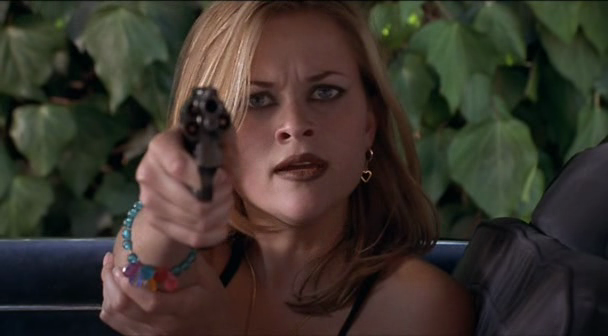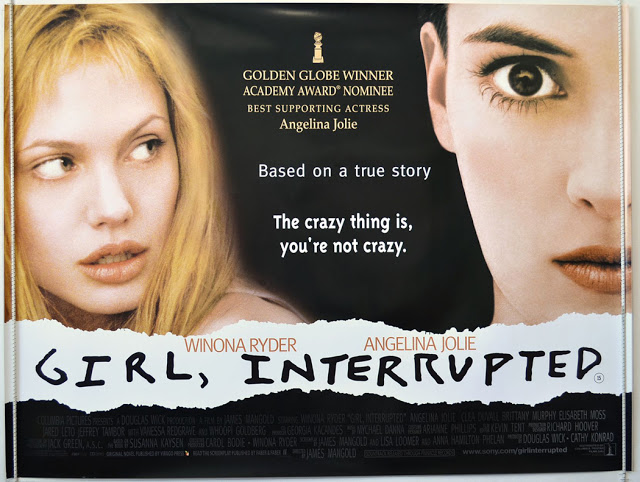This post by Ren Jender appears as part of our theme week on Rape Revenge Fantasies.
In films, as in life, women aren’t supposed to be violent. Women make up the majority of violent crime victims (domestic violence, assault, rape, and murder) but they don’t usually retaliate in kind. Even in the relatively rare film where a woman seriously injures or kills a rapist, like Thelma and Louise, she does so with lots of tears and anguish–in that film from both from the woman pulling the trigger and the one whom the man attempted to rape. The unwritten rule in movies seems to be that in order to justify a woman killing or even assaulting someone, we need to see her or some other woman suffer, a lot, beforehand. Contrast that rule with the male heroes of action films who leave dozens of corpses in their wake, and not one of the dead has raped or otherwise tortured the hero beforehand–though the hero may be avenging some great wrong the dead guy (or guys) did to his wife or daughter.
Any experienced moviegoer will see all the signs in the beginning of Freeway pointing to the eventual degradation of its protagonist Vanessa (played by a pre-stardom Reese Witherspoon). She’s an “illiterate” (a script this uneven should be careful about throwing that word around) high school student in a midriff-baring halter top (the film is a runway of 90s fashion that would best be forgotten) who fights off her meth-head stepfather’s advances while her mother does sex work to support her own meth habit. After both her parents are arrested the movie takes off (and finds its comic horror tone) when Vanessa is left alone with her social worker, who doesn’t see any other option but foster care. While addressing the woman in the most respectful manner (“I’ll leave the keys on the TV”), Vanessa chains her to the bed and escapes.
As she sets off, Vanessa wears a red leather jacket and carries her things (including cans of beer) in a wicker basket, evoking Little Red Riding Hood (as do the tacky, sexist illustrations under the opening credits). She makes her way along the freeway to where her grandmother lives.

The family shitbox car breaks down, and Bob (a pre-24 Kiefer Sutherland), who is driving by, sees her ass bent over the open hood and stops to help. When he can’t fix the car, he offers her a ride, which she accepts. Bob, in his shiny SUV, pleated khakis, and glasses, talks like Mr. Rogers and works as a therapist. He gets Vanessa to speak at length with him about her troubled background, including her stepfather’s sexual abuse. But when (while still driving) he initiates a “powerful new” therapy in which he asks Vanessa to detail her feelings using explicit language and humiliating details she figures out that, like many men who pretend to help women, he’s a creep. When she tries to get out of the car, she finds the door handle is missing, which Bob dangles in front of her and then uses to hit her. We find out Bob is the freeway rapist and killer Vanessa has seen reports about on TV.
Bob holds a razor to her throat and tells her to take off her pants. She stalls him by telling him she will have to unlace her boots first, but kicks him in the head, rolls into the backseat and holds a loaded gun to his head while shrieking at him to drop the razor out of the window. She hits the back of his head with the gun more than once while he drives, then instructs him to pull over into a middle-of-nowhere exit. When he tries to talk her out of it, she shrieks, “You want to get shot a bunch of times?” Vanessa’s rage in this and later scenes is like an altered state from her usual manner, but she’s not hysterical. When they stop, Bob plays the role usually played by a woman in a movie, crying and pleading for his life while Vanessa decides what she should do with him. “The time for talk is over now,” she tells him, adopting his therapist demeanor. She asks if he’s accepted Jesus Christ as his personal savior, and when he says he has, she says in a thoughtful way, “That’s good. That’s really good.” At this point I thought she would let him go, because of the unwritten rule: we hadn’t seen her subjugated, and she could probably get away without further violence. Instead she shoots him in the neck and leaves him for dead.
She makes her way to a truck stop diner, covered in blood (again part of the Red Riding Hood motif). She’s arrested as she leaves. We see her entering the juvenile detention facility, her face scrubbed of her heavy eye-makeup, so she looks young, vulnerable, and angelic. When one “chola,” Mesquita (Alanna Ubach), and her companions start to threaten her (as, we learn later, a first step in getting Vanessa to “put out”) we think the movie will turn into Born Innocent (this film even has, as Born Innocent did, a weird young lesbian inmate, but this one is a character, not a predator, and is played by an excellent Brittany Murphy) or any of the other women-in-prison films in which the new inmate is assaulted–except Vanessa’s the one who attacks first–and keeps on punching. She yells at Mesquita all the while, beating her into unconsciousness and turning her face into a bloody mess until the staff grab Vanessa and throw her into solitary–where she uses her time alone to make a shiv.

In her preliminary hearing Vanessa sees that Bob isn’t dead, but is left with permanent disfiguring injuries. He, of course, is posing as an innocent victim of a robbery, and just as he predicted–before she shot him–the authorities believe his word, not hers. “Holy shit,” she says, her eyes opening wide as she sees him across the courtroom and we steel ourselves for her inevitable tears, anguish and suffering, but we don’t get them. Instead, Vanessa taunts him in her thick Southern accent, “Look who got hit with the ugly stick!” When he and his wife later appear on television (to lobby for juveniles like Vanessa to be tried as adults) she watches with the other girls at the facility and taunts him further, imitating his electronically aided voice and alluding to his grotesquely distorted mouth, “My dick may not function, but I haven’t lost my smile.”
Women in films and in life are sorry for so many things, all the time, even those things that aren’t their fault; a film heroine (or antiheroine) like Vanessa, so hilariously unrepentant about her acts of violence, is a triumph. Also refreshing for the audience is being in the position of cheering on a woman threatening and assaulting men (Mesquita is Vanessa’s only female victim, and they become feminist allies by the end) when so much film and television continues to offer up men’s abuse of women–sexual and otherwise–as entertainment.
The writer-director Matthew Bright doesn’t exactly have a magic touch with all the actors (Michael T. Weiss as the stepfather and Brooke Shields as Bob’s wife are particularly execrable), and some of what passes as “satire” in the script, especially before Vanessa gets on the freeway, falls as flat as the worst Saturday Night Live skits. But Witherspoon’s Vanessa shows off the expert comic timing she would later become famous for. She also gets all the best lines. Her scenes with Sutherland (who is great at projecting both creepiness and “normalcy”) when she has her gun on him are a stellar parody of the therapist-patient relationship, with the roles reversed. Her Vanessa also uses her voice to make up for her small stature when she intimidates her victims, the way Ben Kingsley’s character did in Sexy Beast. With Dan Hedaya as one of the police detectives on her case it’s easy to see Vanessa as the violent, class-conscious, NC-17 (the film was censored to finally receive an R rating) version of the main character, Cher, in Clueless (Hedaya played Cher’s father in the film, which was released one year before Freeway). Both of them are headstrong Southern California blondes whom audiences at first underestimate, but by the end come to respect. Freeway is far from a perfect film but well worth seeing, even for those who don’t count themselves as fans of Witherspoon.
[youtube_sc url=”http://www.youtube.com/watch?v=_eQbglH0FJ4″]
___________________________________________________
Ren Jender is a queer writer-performer/producer putting a film together. Her writing has appeared in The Toast, xoJane, and the Feminist Wire. You can follow her on Twitter @renjender.











